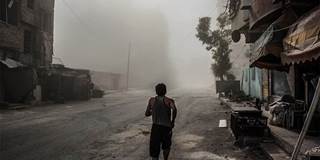The ongoing bloodletting in Syria is not only the world's greatest humanitarian disaster by far, but also represents one of its gravest geopolitical risks. And America's current approach – a two-front war against the Islamic State and President Bashar al-Assad's regime – has failed miserably.
NEW YORK – The ongoing bloodletting in Syria is not only the world’s greatest humanitarian disaster by far, but also one of its gravest geopolitical risks. And the United States’ current approach – a two-front war against the Islamic State and President Bashar al-Assad’s regime – has failed miserably. The solution to the Syrian crisis, including the growing refugee crisis in Europe, must run through the United Nations Security Council.

NEW YORK – The ongoing bloodletting in Syria is not only the world’s greatest humanitarian disaster by far, but also one of its gravest geopolitical risks. And the United States’ current approach – a two-front war against the Islamic State and President Bashar al-Assad’s regime – has failed miserably. The solution to the Syrian crisis, including the growing refugee crisis in Europe, must run through the United Nations Security Council.